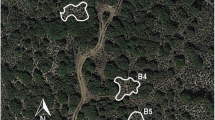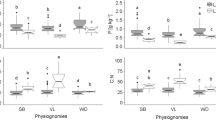Abstract
Previous studies have tested the “vernal dam” hypothesis of spring ephemeral herbs in hardwood forests. The desert annual is a component of the desert ecosystem that takes advantage of water resources and temperature conditions during the rainy season to rapidly complete its life cycle within several months. To understand the role desert annual/ephemeral plants play in nutrient flow, we studied vegetation cover, nitrogen content and litter production of annual plants and litter decomposition rate in plant communities dominated by four shrubs (Haloxlon ammodendron, Hedysarum scoparium, Calligonum mongolicum, and Nitraria tangutorum) and two dominant annuals (Agriophyllum squarrosum and Halogeton arachnoideus Moq) in Minqin, northwestern China. Results indicate that over half of the total vegetation cover was provided by annuals. Annuals also took up a large amount of nitrogen (0.46–3.78 g N m−2) along the oasis–desert ecotone. Litter production and nutrient content were higher in areas dominated by annual plants than in areas dominated by shrubs. Furthermore, the litter decomposition rate of the annuals was higher than that of the shrubs, except for the shrub H. ammodendron, although almost all of the litter’s carbon (C) and nitrogen (N) remained after 6 months of decomposition. Without the annuals, more nutrients and rainwater might be lost through leaching or dust transfer caused by the wind erosion. In addition, green twigs of the annuals are the food for some animals, we found some green twigs and litter from annuals left in front of gerbil and rabbit burrows, sometimes even blocking these burrows. Thus, desert summer annuals, like nutrient reservoirs and providers, take up nutrients during the rainy season, providing some animals and microbes with food, and finally release these nutrients after death.





Similar content being viewed by others
References
Adondakis S, Venable DL (2004) Dormancy and germination in a guild of Sonoran Desert annuals. Ecology 85:2582–2590. doi:10.1890/03-0587
Allen SE (1989) Chemical analysis of ecological materials. Blackwell, Oxford
Beatley JC (1974) Phenological events and their environmental triggers in Mojave Desert ecosystems. Ecology 55:856–863. doi:10.2307/1934421
Blank JL, Olson RK, Vitousek PM (1980) Nutrient uptake by a diverse spring annual community. Oecologia 47:96–98. doi:10.1007/BF00541781
Bocock KL, Gilbert O (1957) The disappearance of leaf litter under different woodland conditions. Plant Soil 9:179–185. doi:10.1007/BF01398924
Brooks ML (2000) Competition between alien annual grasses and native annual plants in the Mojave Desert. Am Midl Nat 144:92–108. doi:10.1674/0003-0031(2000)144[0092:CBAAGA]2.0.CO;2
Chen BM, Wang GX, Cheng DL, Deng JM, Peng SL (2007) Vegetation change and soil nutrient distribution along an oasis–desert transitional zone in northwestern China. J Integr Plant Biol 49(11):1537–1547. doi:10.1111/j.1774-7909.2007.00531.x
DeFalco LA, Detling JK, Tracy CR, Warren SD (2001) Physiological variation among native and exotic winter annual plants associated with microbiotic crusts in the Mojave Desert. Plant Soil 234:1–14. doi:10.1023/A:1010323001006
Eickmeier WG, Schussler EE (1993) Responses of the spring ephemeral Claytonia virginica L. to light and nutrient manipulations and implications for the “vernal-dam” hypothesis. Bull Torrey Bot Club 120(2):157–165. doi:10.2307/2996945
Ettershank G, Ettershank J, Bryant M, Whitford WG (1978) Effects of nitrogen fertilization on primary production in a Chihuahuan Desert ecosystem. J Arid Environ 1:135–139
Evans RD, Belnap J (1999) Long-term consequences of disturbance on nitrogen dynamics in an arid ecosystem. Ecology 80:150–160
Evans RD, Ehleringer JR (1993) A break in the nitrogen cycle in arid lands? Evidence from δ15N of soils. Oecologia 94:314–317. doi:10.1007/BF00317104
Fernández RJ, Reynolds JF (2000) Potential growth and drought tolerance of eight desert grasses: lack of a trade-off? Oecologia 123:90–98. doi:10.1007/s004420050993
Fisher FM, Zak JC, Cunningham GL, Whitford WG (1988) Water and nitrogen effects on growth allocation patterns of creosotebush in the northern Chihuahuan Desert. J Range Manage 41:387–391. doi:10.2307/3899572
Forseth IN, Ehleringer JR, Werk KS, Cook CS (1984) Field water relations of Sonoran Desert annuals. Ecology 65:1436–1444. doi:10.2307/1939124
Freas KE, Kemp PR (1983) Some relationships between environmental reliability and seed dormancy in desert annual plants. J Ecol 71:211–217. doi:10.2307/2259973
Guo Q, Brown JH (1997) Interactions between winter and summer annuals in the Chihuahuan Desert. Oecologia 111:123–128. doi:10.1007/s004420050215
Gutierrez JR, Whitford WG (1987) Chihuahuan desert annuals: importance of water and nitrogen. Ecology 68:2032–2045. doi:10.2307/1939894
Gutterman Y (2000) Environment factors and survival strategies of annual plant species in the Negev Desert, Israel. Plant Species Biol 15:113–125. doi:10.1046/j.1442-1984.2000.00032.x
Halvorson WL, Patten DT (1975) Productivity and flowering of winter ephemerals in relation to Sonoran Desert shrubs. Am Midl Nat 93:311–319. doi:10.2307/2424164
Han FG, Wang J (2002) The ecological climate resources and its exploitation along the edge of Minqin oasis. J Arid Land Resour Environ 16(3):51–56
Li XR, **ao HL, Zhang JG, Wang XP (2004) Long-term ecosystem effects of sand-binding vegetation in Shapotou region of Tengger Desert, Northern China. Restor Ecol 12:376–390. doi:10.1111/j.1061-2971.2004.00313.x
Martínez-mena M, Rogel JA, Castillo V, Albaladejo J (2002) Organic carbon and nitrogen losses influenced by vegetation removal in a semiarid mediterranean soil. Biogeochemistry 61:309–321. doi:10.1023/A:1020257208048
Muller RN, Bormann FH (1976) Role of Erythronium americanum Kerin energy flow and nutrient dynamics of a northern hardwood forest ecosystem. Science 193:1126–1128. doi:10.1126/science.193.4258.1126
Mulroy TW, Rundel PW (1977) Annual plants: adaptations to desert environments. Bioscience 27:109–114. doi:10.2307/1297607
Pan WB, Huang PY (1995) The ecology of four ephemeral plants. Acta Phytoecol Sin 19:85–91
Parker LW, Santos PF, Phillips J, Whitford WG (1984) Carbon and nitrogen dynamics during the decomposition of litter and roots of a Chihuahuan Desert annual Lepidium lasiocarpum. Ecol Monogr 54:339–360. doi:10.2307/1942501
Peterjohn WT, Schlesinger WH (1990) Nitrogen loss form deserts in the southwestern United States. Biogeochemistry 10:67–79. doi:10.1007/BF00000893
Prospero JM, Lamb PJ (2003) African droughts and dust transport to the Caribbean: climate change implications. Science 302:1024–1027. doi:10.1126/science.1089915
Rothstein DE (2000) Spring ephemeral herbs and nitrogen cycling in a northern hardwood forest: an experimental test of the vernal dam hypothesis. Oecologia 124:446–453. doi:10.1007/PL00008870
Schaeffer SM, Billings SA, Evans RD (2003) Responses of soil nitrogen dynamics in a Mojave Desert ecosystem to manipulations in soil carbon and nitrogen availability. Oecologia 134:547–553
Singh KP, Singh PK, Tripathi SK (1999) Litterfall, litter decomposition and nutrient release patterns in four native tree species raised on coal mine spoil at Singrauli, India. Biol Fertil Soils 29:371–378. doi:10.1007/s003740050567
Walvoord MA, Phillips FM, Stonestrom DA, Evans RD, Hartsough PC, Newman BD, Striegl RG (2003) A reservoir of nitrate beneath desert soils. Science 302:1021–1024. doi:10.1126/science.1086435
Wang X, Jiang J, Lei J, Zhang W, Qian Y (2003) Distribution of ephemeral plants and their significance in dune stabilization in Gurbantunggut Desert. J Geogr Sci 13(3):323–330. doi:10.1007/BF02837507
Weltzin JF, Tissue DT (2003) Resource pulses in arid environments—patterns of rain, patterns of life. New Phytol 157:171–173. doi:10.1046/j.1469-8137.2003.00672.x
Went FW (1949) Ecology of desert plants II. The effects of rain and temperature on germination and growth. Ecology 30:1–13. doi:10.2307/1932273
Werk KS, Ehleringer JR, Forseth IN, Cook CS (1983) Photosynthetic characteristics of Sonoran Desert winter annuals. Oecologia 59:101–105. doi:10.1007/BF00388081
Zaady E, Groffman PM, Shachak M (1996) Litter as a regulator of N and C dynamics in macrophytic patches in Negev Desert soils. Soil Biol Biochem 28:39–46. doi:10.1016/0038-0717(95)00097-6
Zak DR, Groffman PM, Pregitzer KS, Christensen S, Tiedje JM (1990) The vernal dam: plant-microbe competition for nitrogen in northern hardwood forests. Ecology 71:651–656. doi:10.2307/1940319
Acknowledgments
The study was supported by the Open Fund of State Key Laboratory of Biocontrol (SKLBC08K02) of Sun Yat-Sen University and National Natural Science Foundation of China (30730020, U0633002). We are grateful to the colleagues of Lanzhou University and the colleagues of Minqin Desert and Experiment Station of Gansu Desert Control Research Institute who contributed to the completion of this research.
Author information
Authors and Affiliations
Corresponding author
Additional information
Bao-Ming Chen and Gen-Xuan Wang contributed equally to this work.
Rights and permissions
About this article
Cite this article
Chen, BM., Wang, GX. & Peng, SL. Role of desert annuals in nutrient flow in arid area of Northwestern China: a nutrient reservoir and provider. Plant Ecol 201, 401–409 (2009). https://doi.org/10.1007/s11258-008-9526-7
Received:
Accepted:
Published:
Issue Date:
DOI: https://doi.org/10.1007/s11258-008-9526-7




